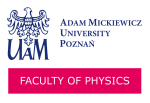Spin waves in hybrid nanostructures
We are looking for the graduate student willing to start the PhD studies and involve in the research financed by the National Science Center- Poland in the framework of the project PRELUDIUM-BIS-2 (2020/39/O/ ST5/02110) Spin waves in hybrid nanostructures – the role of surface anisotropy, led by Prof. Jarosław W. Kłos form Department of Nanostructures Physics.
Scholarship
During four years of study, doctoral student receives a scholarship of 5,000 PLN for the first two years of study (before the mid-term evaluation) and 6,000 PLN for the next two years, after the mid-term evaluation. The amount of 11.26% will be subtracted from the scholarship for the obligatory fee of the national social insurance system (ZUS).
PhD studies
The competition is addressed to people who plan to start education at the Doctoral School at the University of Adam Mickiewicz in Poznań in 2021/2022 and is an elite path of financing doctoral students beyond the limit of the doctoral school.
Internship
The research will be conducted in an international research team, in cooperation with a leading research group in Spain, Germany, and Austria. The cooperation allows participating international scientific schools and conferences as well as to complete foreign internships. As part of the project, a 6-month internship abroad at the University of the Basque Country (San Sebastian) is planned for the PhD student in the theoretical group of prof. Konstantin Guslienko, additionally financed by the NAWA agency and several short-term internships in cooperating experimental groups.
Information about the host >>>
Recruitment
Schedule of the Doctoral School enrollment procedure:
- Registration in the Candidate Online Registration system (IRK): 1 July – 31 August, 2021, https://usosirk.amu.edu.pl/en-gb/offer/SD-2021/programme/SD-NFiz-G5/
- Submission of documents: 1 July – 31 August, 2021
- Selection procedure: 6-10 September, 2021
- Announcement of the list of admitted candidates: 15 September, 2021
Detailed information about recruitment (fee and required documents) >>>
Scope of work in the frame work of the poject
The PhD student will be involved in numerical simulation based on the finite element method using the COMSOL platform. She/he will also develop the theoretical models describing the spin waves dynamics, elastodynamics, and eddy currents dynamics in superconductor (in Meissner) state which can be then implemented in COMSOL Multiphysics. Particular attention will be paid to the introduction of proper boundary conditions for the wave excitation in the considered hybrid systems.
Required professional qualifications
The following qualifications and skills are required from the recruited PhD student:
- master degree in physics, material science, or in a similar scientific discipline,
- theoretical background in solid-state physics, the complement of the mathematics courses (linear algebra, partial differential equations),
- programming skills (Phyton programming preferred),
- the knowledge of the COMSOL environment will be advantageous.
Desciption of the project
Spin waves are precessive magnetization oscillations propagating in a magnetic material. Typical spin wave frequencies (from several to several dozen GHz) correspond to relatively short wavelengths (from several to several hundred nanometers). As a result, spin waves can be processed into nanostructures and used for unconventional wave-based calculations.
The properties of spin waves can be influenced by the appropriate selection of the magnetic materials or the sizes of the nanostructure in which they propagate. However, the scope of these changes is limited to some extent. Additional possibilities of shaping the dynamics of spin waves are provided by hybrid systems, which use the interaction of spin waves with other excitations, e.g., with elastic waves or with an alternating electric current. This approach also allows the control of spin waves by external, non-magnetic stimuli (e.g., mechanical stress or electrical voltage). As part of the project, the tested hybrid systems were hybrid systems in which a magnetic system was combined with (i) elastic or (ii) superconducting system in one structure.
An important parameter directly influencing the properties of spin waves is the so-called surface anisotropy, which describes the change in spin wave energy due to the presence of the surface. This parameter, together with the magnetic dipolar effects, determines the dynamics of the spin wave on the surface of the magnetic material – observed as a so-called partial pinning a spin wave. We believe that the surface anisotropy will be of particular importance in the hybrid systems we investigate. This is due to the following reasons:
– surface anisotropy affects the boundary conditions at the interface separating the magnetic and non-magnetic components of the hybrid structure,
– change of the surface anisotropy influences directly the spatial distribution of the spin wave amplitude, which should be important for the interaction of the spin wave with another excitation penetrating the magnetic subsystem (e.g. (i) an elastic waves or (ii) a magnetic field created by a superconducting current),
– surface magnetic anisotropy can be changed by mechanical stress or/and electric field – which may be an additional factor influencing the coupling in hybrid structures.
In the framework of the project, the numerical and theoretical research will be carried out on the dynamics of spin waves in hybrid planar nanostructures – the ferromagnetic system (i) coupled elastically with a non-magnetic system or (ii) coupled with a superconductor through the field generated by the so-called eddy currents. Numerical and theoretical research conducted by the Ph.D. student will be supported by experimental research performed by cooperating teams.
Detailed information about the project >>>
For more information please contact with project leader Prof. Jarosław W. Kłos (klos@amu.edu.pl).


